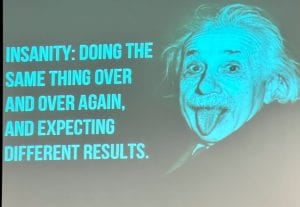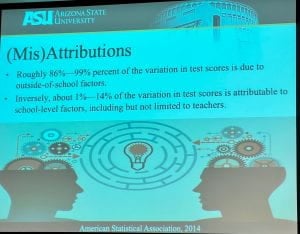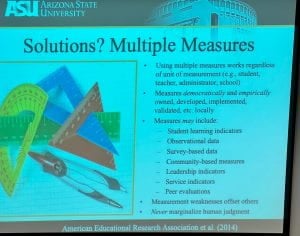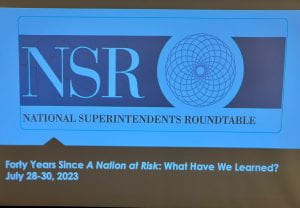 In this fourth of four blog posts illustrating forty years of educational reforms in the United States since the publication of A Nation at Risk in 1983, I am proud to reinforce some of what I knew, know, and plan to do! The report gave a start to decades of educational reforms that helped to cause a national obsession with standardized test results. Some of the momentum has been great in terms of causing an awareness of what it means for a school system to educate each child every day — some of the momentum has been horrible in terms of causing people who score “less than proficient” to be looked upon as illiterate.
In this fourth of four blog posts illustrating forty years of educational reforms in the United States since the publication of A Nation at Risk in 1983, I am proud to reinforce some of what I knew, know, and plan to do! The report gave a start to decades of educational reforms that helped to cause a national obsession with standardized test results. Some of the momentum has been great in terms of causing an awareness of what it means for a school system to educate each child every day — some of the momentum has been horrible in terms of causing people who score “less than proficient” to be looked upon as illiterate.
So … in a nation where soundbites rule and folks no longer read a lot of content, except for readers of this blog – of course! On a five-point scale, for example, in Illinois, at the end of year high stakes assessment, students who score a 4 or a 5 are labeled “proficient,” and anyone with a 3, a 2, or a 1 is NOT. And if you are NOT proficient, the narrative calls for you and for your school to become failures.
I know this sounds kind of dramatic, and I know it sounds overly simplified — and it is –, but that’s what 40 years of “reforms” and an obsession with standardized test scores to rate and rank the nation’s public schools have yielded. Make no mistake, I am all for accountability, and I preside over a public school district where I want each

Worthy of review and discussion especially 40 years past the “reform” movement …
child to be proficient in all of the standards (knowledge, skills, performance indicators). I absolutely understand the need for academic measures to show the public they are getting a positive return on their investment of public tax dollars, and in my district, I’m proud to report that they are.
My issues are that one score at one point in time does not accurately reflect or show the actual quality of education of the school or of the district. The child with a score of 3 (in the above example), for example, and clarity – is literate. He can read. He can compute. He is somewhere behind the “proficient” rating put upon him by the state … and in the 50 different states, there are different measuring sticks for proficiency… what else have I learned about 40 years of reform? It’s not been equally implemented. It’s not been equitably implemented; it’s not been fairly implemented.
Instead of “A Nation at Risk,” – they might have been more accurate if they entitled the report “50 states do public education differently, and we have no idea if the nation is at risk” …Our nation might have been at risk, it might be at risk today – I’m not fully qualified to make that assessment nor can I declaratively make that conclusion, I can, though, indicate that my local public school district is NOT at risk. We have work to do, and we are committed to continuous improvement. We rely on measures of culture, satisfaction, customer service, financial responsibility, student learning, and student growth, among others, to assess our successes and our needs for improvement.

Solutions we discussed and that were presented by professor.
I do question the “proficiency” rates and the complete “wall” between a 3 and a 4 in the end-of-year Illinois test. We do all we can each day for each child to get our students’ knowledge, skills, and abilities to meet and exceed the standards set. Thanks to input and, dialogue, and intellectual discourse with leaders all across the United States, including from the District of Columbia, CA, IL, OH, IN, TX, MI, PA, MD, NY, CO, & AZ, my thinking was challenged and my analyses of the past forty years of American education in the United States was enhanced.
We talked about “the science of reading”, various political groups engaged in local school board elections, the existence of school boards themselves, local control issues, state issues, civil rights issues, and much, much more! Some among us called for a “Marshall Plan” for public education to restore the prestige and invest in getting more teachers (and educational support personnel and administrators) into classrooms, schools, and districts. We discussed the structure of education itself, the roles of state and federal, and local governments, and the pros and cons of each.
Let’s all remember that in the United States of America, we have the most patents in the world, we have the largest economy in the world, and we have the strongest military in the world. With 90% of students in our public schools, clearly, our Nation is NOT at risk due to the public schools. One could surmise that in the forty years since A Nation at Risk, we have learned much, and we are successful in many areas.
I strongly believe it’s time to change the narrative that the USA is at risk due to the public schools. In contrast, we’re doing so well BECAUSE of the nation’s public schools. I also believe it is time for us all to accept that it’s statistically impossible for “all” to be “proficient” on a bell-shaped curve – with 50 as “normal,” there will always be less than and more than. It is time to develop a more realistic accountability system that means more than “average” or “beyond or below”.
be less than and more than. It is time to develop a more realistic accountability system that means more than “average” or “beyond or below”.
Finally, I thank the National Superintendent Roundtable for convening us so thoughtfully, so provocatively, and so meaningfully as we ponder the past forty years in US public education – and as we forecast the next decades. Our nation and our world have endured powerful changes due to public education. Let’s commit to sharing the correct narrative, and let’s believe in each child every day with rigor and high expectations, and high standards. Let’s measure what we’re actually doing and let’s get it right in the next 40 years!

Leave a Reply